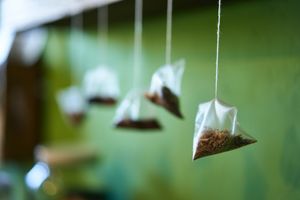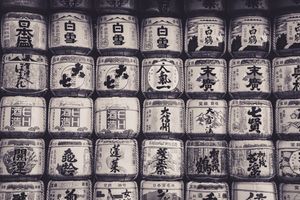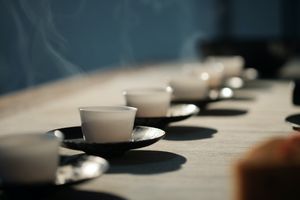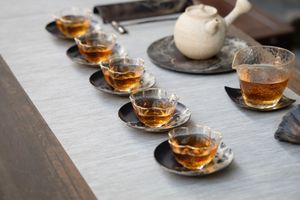Best Tasting Teas For Beginners & Non-Tea Drinkers
By Andrew Warner

Can’t tell your oolong from your matcha from your masala chai? You’re in the right place. If you’re looking to refine your taste for different types of tea or hoping to boost your health, we’ve got you covered with this comprehensive guide to teas and brewing methods.
Most of us have probably had a cup of tea or two at some point in our lives. But if tea’s never really been your thing, you may find yourself curious to know what all the fuss is about — after all, it’s the second-most widely consumed beverage worldwide (and it’s first if you don’t count water!).
In this article, we’ll give you a brief glimpse into the wonderful and diverse world of tea, full of tips for beginners and non-tea drinkers to gear up for their journey to becoming a well-versed tea aficionado. We’ve compiled a list of the best tea for beginners, along with a handful of frequently asked questions about brewing and selecting tea.
Five Best Tasting Tea Flavors For Non-Tea Drinkers
While there are hundreds — maybe even thousands — of different strains and blends of tea types, all of these can be categorized into five main groups. With the exception of herbal teas (which are brewed from a different plant entirely), these groups refer mainly to the different processing methods used to develop the final product.
The difference in processing methods can have a profound impact on the color and flavor profile of your cup of tea. If tea producers leave the tea out to ferment completely, you’ll wind up with a malty and robust cup of black tea. On the other hand, foregoing the fermentation process entirely will yield a light, fruity cup of white tea.
Tea (once again, excluding herbal teas) comes from the Camellia sinensis bush, grown mainly in warm, humid regions near the tropics. Once the tea leaves are harvested, there are a handful of different ways to dry and ferment the tea. Here are the five main varieties of tea a new tea drinker ought to know as they begin exploring the world of tea.
- White Tea
The first on our list also happens to be the most delicate. Of the different types of tea out there, white tea is the least processed. Tea processors typically ferment (or more precisely, “oxidate”) withered tea leaves, allowing them to turn a brownish color. With white tea, however, tea processors skip the oxidation process entirely.
This means its flavor profile tends to more closely resemble the floral and citrusy notes of fresh tea leaves. Best brewed at a lower temperature for a brief 1- to 2-minute time period, white tea has a very light quality to it. Oxidation also allows caffeine to build up in the leaves, so white tea is low in caffeine compared to other varieties. That means it’s a particularly good choice for tea lovers looking for an after-dinner nightcap to sip on in the evenings.
Here are some white teas we recommend: Twinings White Tea, Imozai Organic White Tea, Teamonk Kimaya White Tea
- Green Tea
This is a particularly popular option. Green tea varieties are very lightly oxidized, but not quite as much as a black or oolong variety. The flavor profile of green teas can vary widely from variety to variety. Generally speaking, however, they’re a bit less fruity than white teas and a bit grassier than black teas.
Green tea is especially well-liked in East Asian tea cultures. China and Japan are especially well-known for their green tea varieties, such as sencha, matcha and gunpowder tea. Chinese green tea leaves are usually best on their own, without the addition of milk or sugar. That said, stronger varieties like matcha hold up well to milk and sweetener, so it’s worth testing out different serving styles. This way, you can figure out what works best for your palate.
Here are some green teas we recommend: VAHDAM Organic Green Tea, Tealyra Sencha Kakegawa, Yan Hou Tang Organic Matcha Green Tea
- Oolong Tea
Next up on our list is oolong. This type of tea has a brownish color somewhere in between the vibrant greens of green tea and the dark notes of black tea. Like green tea, oolong isn’t completely fermented, so it maintains some of those light grassy notes, but it’s a bit more malty than your typical green tea.
Oolong has a bold and robust flavor. It’s very popular in China, which is also where it originated. Legend has it that the tea is named after a tea processor named Wu Liang, who accidentally left a batch of green tea out to ferment for a little bit too long after getting distracted. But try not to get distracted yourself when brewing a cup of oolong or it may become too bitter. Oolong is a bit less forgiving than the other varieties on this list when it comes to over-steeping.
Here are some oolong teas we recommend: Xin Qing Oolong Tea, FGO Organic Oolong Tea, Allegro Tea Organic Splendid Oolong
- Black Tea
Black tea is the last major type of tea produced using Camellia sinensis. Black tea is most popular in Southeast Asia and Europe. These tea leaves are fully oxidized, which lends them the characteristic dark color they’re named for. It also tends to have the highest caffeine content of the other varieties on the list. Popular options are Ceylon, Darjeeling and Assam black tea grown in India.
Black tea is commonly blended with other spices or ingredients to infuse the tea with a complex flavor profile. For example, traditional chai tea consists of black tea spiked with cardamom, ginger and cinnamon. Likewise, adding bergamot essential oils to black tea leaves creates a citrusy Earl Grey tea. Because of its deep, earthy flavors, black tea pairs particularly well with a splash of milk and sugar. If you like something on the creamier side, black tea may be the right option for you.
Here are some black teas we recommend: Asli Assam, Blue Lotus Chai - Traditional Masala Chai, Bigelow Earl Grey
- Herbal Tea
Technically, herbal tea isn’t really a tea at all. Herbal teas are any sort of tea-like concoction brewed using plants other than Camellia sinensis. This includes herbs and flowers like peppermint, hibiscus, rooibos tea and chamomile, among many others. Sometimes, these are called tisanes as well.
There are so many different kinds of herbal tea that it would be impossible to make a generalization about their flavor profiles. After all, the cool notes of spearmint are completely unlike the acidic and vibrant flavors of hibiscus. However, the most popular herbal teas tend to be entirely caffeine-free. Because of this, they’re the perfect nighttime option.
Here are some herbal teas we recommend: TAZO Passion Tea, Taylors of Harrogate Organic Peppermint, Buddha Teas Organic Lavender Tea

How To Start Drinking Tea in Three Easy Steps
It can be daunting getting started — after all, there are a lot of different teas to choose from and all sorts of different brewing methods. There’s no one-size-fits-all solution when it comes to brewing methods either — what works for a green tea might not necessarily work for your favorite black tea.
Still, it’s surprisingly simple to embark on your journey to becoming a knowledgeable lover of tea. You just need to be willing to embrace the trial and error aspect of the process. Here, we’ve collected a series of easy steps to help you get the process going.
Use Easy to Brew Teas
Some teas are fussier than others. When you’re just learning how to brew your own tea, you probably don’t want to break the bank on a fancy, delicate oolong. Instead, you want to stick to teas that are a bit more forgiving.
White teas and herbal teas are particularly simple to brew. It’s hard to over-steep herbal teas, which often call for a brew time of 10 to 15 minutes. Likewise, white teas tend to be low in tannins, which are the bitter flavor compounds that build up in your cup of tea the longer you steep your tea leaves.
That said, you can also find all sorts of tea types that are easy to brew. Each type of tea does have an ideal brewing time and temperature. However, these aren’t hard and fast rules — if you accidentally brew your green tea at 212 degrees Fahrenheit instead of the recommended 180, it’s not going to be the end of the world. When you’re first starting out, you may want to purchase teas that come at a lower price point. That’s not to say you should buy low-quality or cheap teas — but it’s much better to experiment with less expensive options before blowing away your hard-earned cash on what’s likely to be a much more sensitive variety of tea leaves.
Make it Habitual
After selecting a couple of teas to start out with, you’ll want to brew them regularly. This way, you can get a feel for the flavors you like best. You’ll also gain a better understanding of how things like water temperature and brewing time affect the final product.
Adding tea into your daily routine is fairly simple — perhaps you can replace your morning cup of coffee with a cup of strongly brewed English breakfast tea. Or you can indulge in a mug of white tea after dinner.
Creating a tea-drinking habit can allow you to gain some more familiarity with the flavors you enjoy. After all, drinking tea frequently means you’ll have to go out and re-stock your tea pantry almost as frequently. Drinking tea habitually will ensure that you don’t have a box of stale tea bags sitting in the back of your pantry for months on end.
Experiment with brewing techniques
Of course, one of the key ingredients in making a cup of tea is hot water. But just how hot should it be? In part, the answer is up to you.
All tea leaves will have a recommended temperature range, in which the hot water will extract all of the proper flavors without getting too much bitterness. Still, you may find that you like your tea brewed outside of the recommended temperature range. If you happen to have a kettle with a temperature setting, you can set it to just the right temperature each time. If not, no worries. When you’re just starting out, these differences may not be as noticeable.
Likewise, you should try to be flexible with steep times and water type as well. Part of the fun of drinking tea is all the different ways you can drink it — that means there’s an infinite number of brewing techniques you can experiment with. If you like iced tea, try a different brewing technique than you might with hot tea. If you like matcha, you may want to invest in better brewing tech. The options are endless!

What Tea Would I Like? Five Deciding Factors
Because there are so many diverse varieties of tea, you’re practically guaranteed to find a few you like. If you’re not sure where to begin, we’ve got a handful of factors to keep in mind as you select your first few teas.
Previous Experience with Tea
Chances are, you’ve had a couple cups of tea throughout your life, even if you don’t consider yourself a big tea lover yet. Think back to the teas you’ve tasted and what you liked or didn’t like about them. Perhaps you had a toasty genmaicha a couple years ago that you absolutely loved. Or maybe you had a bitter, overpowering black tea that just didn’t suit your palate. Start with the flavors you're familiar with and know you enjoy and work your way out from there.
Flavors you Like
Be sure to read the description of the tea leaves you’re buying. Most tea vendors include a list of tasting notes that give you a simple overview of the flavor profile in each tea. If you love citrusy flavors like orange or lemon, you may like Earl Grey. On the other hand, if you like earthier flavors, a black pu-erh might be right for you.
Flavors you Hate
On the flipside, the description of your tea leaves will also tell you which ones to avoid. If you can’t stand the flavors listed on the packaging, then it’s quite likely you’ll also dislike the tea you’re considering. Try to stick to options that sound appealing when you’re first trying things out, to ensure that you have a pleasant experience early on.
Feelings about Caffeine
Depending on how you feel about caffeine, you may want to avoid certain blends and varieties. Black tea tends to be particularly high in caffeine. That said, the caffeine content in a cup of tea is not nearly as high as that of coffee. If you tend to feel jittery or anxious after one too many cups of coffee, high caffeine varieties of tea may not have the same effect on you. Still, you know your body best — if you’re hesitant about drinking too much caffeine, you may want to opt for herbal teas or white tea.
Loose tea or tea bags
This is a common debate among experienced coffee drinkers. Tea bags offer a degree of convenience that loose leaf doesn’t. On the other hand, loose leaf tea tends to be fresher and more vibrant in flavor. When you’re starting out, you may be tempted to go with tea bags, for the sake of convenience. However, tea infusers are a cheap and equally convenient option that make it easy to brew loose leaf tea. Not to mention, infusers are reusable, making them a more sustainable option than disposable tea bags.

New Tea Drinkers FAQs
What Is the Most Popular Tea Flavor?
The answer to this depends on where you are.
In India and the United Kingdom, black teas like Assam tea, masala chai, Earl Grey and breakfast tea blends tend to be especially popular. These teas have a robust, malty flavor. On the other hand, green teas like jasmine tea and matcha tend to be more popular in East Asian countries like China and Japan. These teas are a bit more floral and grassy than black teas.
When Can You Start Drinking Tea?
When you first start out on your tea journey, you may find it helpful to slowly replace your morning cup of coffee with a breakfast tea blend. If you try herbal teas like chamomile, you can also drink them later in the day. Because tea has a lower caffeine content than coffee, you can drink much more tea throughout the day than you could with coffee. This means there’s no right time to start drinking tea.
Is Tea Healthier than Coffee?
Tea tastes great, but it’s also extremely healthy. Tea has a significant amount of health benefits. High in antioxidants, tea’s health benefits are innumerable. Green tea, for example, is often cited as having slight fat-burning qualities. While coffee also has plenty of health benefits, tea is associated with reduced risk of cancer and heart disease, making it an especially healthy option.
What Is a Good Tea to Drink Daily?
Because of its health benefits, green tea is a particularly good option for those looking to incorporate tea into their daily routine. If you’re trying to cut down on coffee, you may want to add a cup of black tea into your morning regimen — this will help you wake up and stay alert. But really, the best tea to drink daily is whichever tea you like the most.